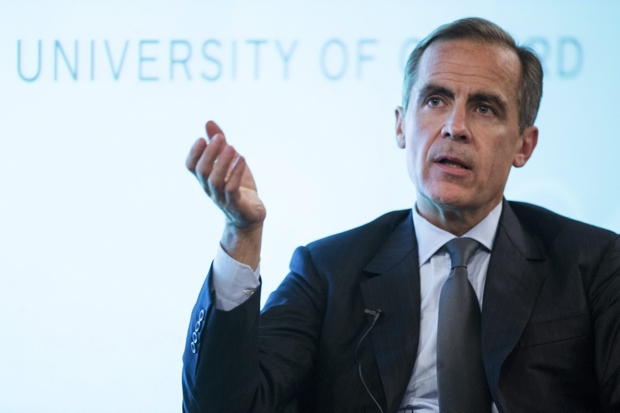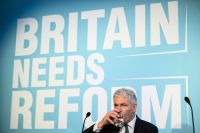Mr S has always been a great admirer of creative accounting: the tricks our politicians use to dress up 50p as £1. It’s not lying, per se. All the techniques need to be valid. But their effect is to mislead. Ed Balls was the great master of this dark art, George Osborne his less-subtle apprentice. Now Mark Carney is stepping in, claiming that the Brexit vote has somehow made people £900 a year worse off.
How can he conjure up this figure, given that his doom-laden projections for the No vote have all been disproven? By using financial spin. A combination of language and statistical skills to “give an appearance of solidity to pure wind,” as Orwell said of political language. Here’s how the financial version is done.
1. Verbal alchemy: the “relative fall” trick. If X has risen, and it suits your political purpose to say that X is in decline, what to do? Compare whatever it is that’s rising against something that is rising even faster. You can then say that X is in ‘decline, relative to Y’. Or why not use a ratio? ‘X is falling, as a percentage of Y’. For example, if the national debt is rising you can disguise this by saying it is “debt is falling as a percentage of GDP’ then wait for the media to shorten this to ‘debt is falling’ (see point 6 below). So when Carney starts referring to “a relative fall in real incomes” and it’s shortened to “incomes”, then – presto! – the rise has been turned into a fall.
Another example: Gordon Brown sought to frame the 2005 election as Labour investment vs Tory cuts. Problem:the Tories proposed to outspend Labour every year – so how to accuse them of cuts? By saying Labour would increase by even more: so the Tories would make “cuts, relative to Labour’s plan,” a phrase designed to be shortened to “cuts”. So by means of this verbal alchemy, the rise becomes a fall.
2. Use estimates as a counter-factual. In Carney’s case, his problem is that UK disposable household income has risen to an all-time high. So how to claim there has been a fall?” When Balls and Osborne tried the “relative fall” trick they would always something real as a competitor (usually GDP); Brown used manifesto pledges. But Carney shows you don’t even need that. You can just use forecasts!
For example, if your annoying neighbour gets a £2,000 pay rise and boasts about it in the pub, you can say: “Well I expected you to get a £4,000 rise! So in fact your wages have suffered a ‘relative fall’ of £2,000! Loser!’ In this real-life example, it sounds nonsense. But in an economic context, you’d be amazed at what you can get away with.
In Carney’s case, he used the Bank of England’s notoriously inaccurate wage forecasts as a counter factual. The 2016 wage forecasts were wrong, as per usual. Out by £900, he says. But here’s his trick: the forecasts were made before Brexit, so he blames Brexit. And he never admitted that BoE wage forecasts are known for being (as even the FT put it) “crappy”.
3. Express percentage rises in cash terms. It’s highly irregular to talk about wage forecasts as £900 gain, or any cash sum. Economists express wage forecasts in terms of percentage rise, and even they have a hefty error margin. For example, the OBR expects earnings to rise by 2.4 per cent next year. Sounds a bit abstract? That’s because it is. But by expressing this in cash, you can give spurious specificity to what is a rough guesstimate. This is what Carney did with his Brexit forecast.
The actual BoE 2016 forecast said wages would rise by 3 per cent that year and 3.75 per cent then next year; they rose by 2.5 per cent and 2.6 per cent. But by converting this into cash, he makes this into a media-friendly £900 cash figure. (George Osborne used this technique with his much-mocked claim that Brexit would make households £4,300 worse off.)
4. No data? No problem! Use forecasts for both figures! . To arrive at his £900 figure, we know that Carney was using 2016 estimates for mid-2018 with the actual. But his problem? It takes ages to collect this actual data, the figures won’t be ready for a while. Using the latest real figures would not take him to £900. So he also used BoE forecasts for the current wage figure. Comparing forecast with forecast: as Orwell might put it, giving the appearance of solidity to pure wind.
5. Stretch the truth as far as you can, drop hints, then rely on the press to do the rest. When a competent Governor or Minister gives a speech, they will know that only a sentence or two will make the news. And what will happen when the message is simplified. So you can lead the media on. Come up with a message that will mislead as soon as it is shortened.
Blair used this technique with his “45 minutes” Iraq dossier, and the Resolution Foundation does this to have newspapers report that this generation of young people is worse-off than their parents. The reports/speeches are worded so as to give this impression – and when the papers report something untrue, the author of the dossier do not complain or seek to correct the record. Because the job – a deception on the public – will have been done.
In this case, Carney could not get away with saying that Brexit was responsible for all of the £900 shortfall. As Bank of England governor, he can only stretch the truth so far. But a clever spinner can use hints, nods and winks then rely on the press to stretch it until the elastic snaps. So we end up with headlines like “Carney: Brexit has cost households £900” (as the BBC put it). This – not the text of his speech – is what the public will see. Job done.
6. Don’t show your working: that gives away the scam. When Osborne launched his £4,300 Brexit figure he was in and out of the Radio4 Today programme studio before the report was released, so journalists were widely reporting the figure without any chance of finding out how it had been cooked up. Carney’s speech on Thursday had plenty of graphs, but none showing how he cooked up £900. Mr S is happy to oblige here.
Mark Carney doesn’t have long to go as Bank of England governor. Mr S recommends a career in politics.







Comments